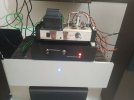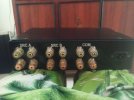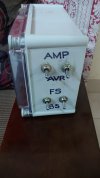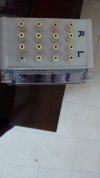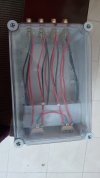You are using an out of date browser. It may not display this or other websites correctly.
You should upgrade or use an alternative browser.
You should upgrade or use an alternative browser.
Amplifier speaker & selector switch with budget stereo amp
- Thread starter manindra.mukherjee
- Start date
Love this. Just few minutes back I have messaged Nishant to see the possibility of him making an enclosure for me.
How did you paint the labels SRC1, SRC2?
It is a stickerLove this. Just few minutes back I have messaged Nishant to see the possibility of him making an enclosure for me.
How did you paint the labels SRC1, SRC2?
If it is for small dimension projects, you may use aluminum flat and angles.I have no clue how to do that. Any tip would help. I have done plenty of google search and I see most of these enclosures available on Aliexpress, but what is available in India are with fixed controls (usually volume + bass + treble).
75mm or 100mm flat bars are commonly available in stores (those that stock parts for aluminum shuttering)
For angles, you may use 15/20/25mm equal angles.
Choose thickness not more than 6mm, if not it will be difficult to drill holes.
These are sold by kilogram, you may have to buy some minimum quantity like 5 or 6 feet length.
Cheers,
Raghu
Last edited:
availlyrics
Well-Known Member
- Joined
- Sep 26, 2011
- Messages
- 295
- Points
- 63
I used plastic box , that came with Amul ice-cream. The reason behind using plastic is its easy to work with. Small iron rod or thick nails, pliers and kitchen gas stove is all that is needed. With aluminum , chances of shorting, special drills or taps are needed and cleaning of burs after work is done. Aluminum enclosures are useful in making amps as they provide thermal cooling and protect from RF interference. One can also try with scrap set-top boxes. , no drilling holes for RCA connectors as it already has it.I have no clue how to do that. Any tip would help. I have done plenty of google search and I see most of these enclosures available on Aliexpress, but what is available in India are with fixed controls (usually volume + bass + treble).
Last edited:
I used a 20 Amps, 230v DPDT switch for each channel.Reviving this thread. I am looking to build an amp changer and would like to know the voltage and current ratings for the switches used.
Thanks for the information. I am assuming that voltage wise anything rated for 120V or more should be fine?
Is it a good idea to use relays with similar rating? This way, I can add a remote or some sort of external trigger mechanism to switch on the fly.
On the other hand, I was also thinking if it makes sense to build a very simple manual switcher with binding post sets for two sources and one output load. If the output set is placed in the center row, I can make simple jumpers with dual banana plugs or short wires to connect any one of the input sets to the output at any time. This should, theoretically, be the better option when considering signal degradation and mechanical wearing of the switches over time.
Lastly, in your experience, does the switch introduce any audible noise/distortion or any other type of sound quality degradation over time?
Is it a good idea to use relays with similar rating? This way, I can add a remote or some sort of external trigger mechanism to switch on the fly.
On the other hand, I was also thinking if it makes sense to build a very simple manual switcher with binding post sets for two sources and one output load. If the output set is placed in the center row, I can make simple jumpers with dual banana plugs or short wires to connect any one of the input sets to the output at any time. This should, theoretically, be the better option when considering signal degradation and mechanical wearing of the switches over time.
Lastly, in your experience, does the switch introduce any audible noise/distortion or any other type of sound quality degradation over time?
Relays idea also good but need external power to operate the relays.Is it a good idea to use relays with similar rating
It's a very good idea.On the other hand, I was also thinking if it makes sense to build a very simple manual switcher with binding post sets for two sources and one output load
I didn't find any sq degradation. If we use same speaker wires for the switch internal wiring or jumpers, i think SQ would remain same.in your experience, does the switch introduce any audible noise/distortion or any other type of sound quality degradation over time?
Thanks! Will most likely take this route as I am planning to build a 5 channel switcher and not just for stereo. I am planning to use the same wires that I am using for the rest of the speaker wiring.It's a very good idea.
For excellent sound that won't break the bank, the 5 Star Award Winning Wharfedale Diamond 12.1 Bookshelf Speakers is the one to consider!
Similar threads
- Replies
- 8
- Views
- 2K
- Replies
- 17
- Views
- 4K
- Replies
- 0
- Views
- 2K


